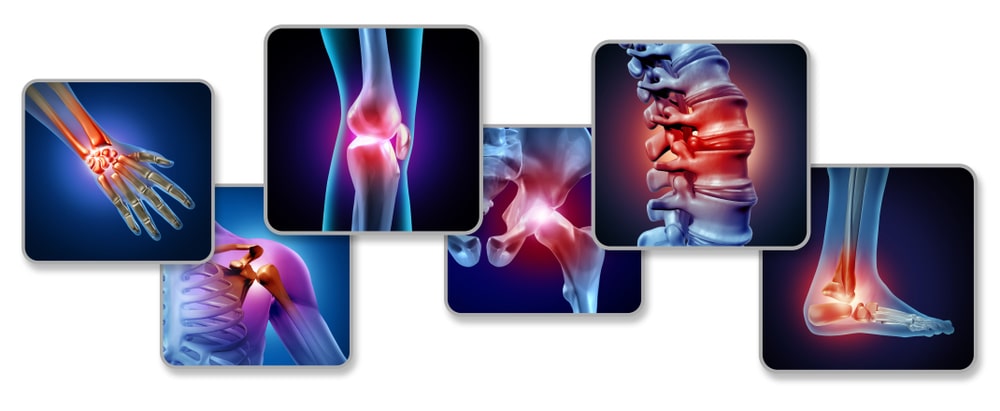A joint is a site at which any two or more bones come together. The joints are classified as fibrous, cartilaginous, and synovial. In fibrous or fixed joints, there is no movement between the bones concerned. There is fibrous tissue between their ends e.g., the joints between the bones of the skull and the joints between the teeth and the maxilla and mandible. In cartilaginous joints, there is a pad of white fibrocartilage between the ends of the bones. Movement is possible because of the compression of the pad of cartilage, e.g. symphysis pubis and joints between the bodies of the vertebrae.
Synovial joints are characterized by the presence of a synovial membrane. A considerable amount of movement is possible. limitations on movement are mainly due to the shape of the bony surface which forms the joint. They are subdivided according to the movements possible.
- Ball and Socket Joint: A hemispherical head fits into a cup-shaped socket e.g., shoulder and hip.
- Hinge Joints: These joints allow movement in one direction only, e.g. elbow, knee and ankle.
- Double Hinge Joints (Condyloid): These allow movements like a hinge in two directions, e.g. the wrist joints and the joints between metacarpus or metatarsus and the phalanges,
- Gliding joints: The bones glide on one another, e.g. between various carpal and tarsal bones.
- Pivot joints: One bone turns on another e.g., the radius on the ulna at the elbow and the atlas on the axis.
Some of the joints are capable of the following types of movements:
- Flexion or bending, usually forward but occasionally backward.
- The extension means strengthening or backward.
- Abduction is the movement away from the midline of the body.
- Adduction is the movement towards the midline of the body.
- Rotation is the movement around the long axis of a bone.
- Pronation means turning the palm of the hand down.
- Supination means turning the palm of the hand up.
- Circumduction is the combination of flexion, extension, abduction, and adduction. It involves movements of the limbs through a circle.
- Inversion is turning the sole of the foot inwards.
- Ex version is turning the son of the foot outward.
Different types of joints help to make different kinds of movements. The ball-and-socket joints are freely movable allowing flexion and extension, abduction, adduction, circumduction, and external and internal rotation. The hinge joints allow flexion and extension only. Double hinge joints allow flexion, extension, adduction, abduction, and circumduction. In the gliding joints, there is only a slight movement increasing the range of movement in all directions. The pivot joints permit rotation around the point where they are pivoted.
The joints are movable, but the movements are carried out by the various muscles. The muscles also run from bone to bone and help to hold the bones in position and give support to the joint capsule, as long as the normal tone is sustained.
Disorders of joints:
Any or all of the structures of joints may be damaged by disease. Inflammation of the joints is called arthritis. Arthritis is of two types; acute and chronic.
Acute Arthritis:
In Rheumatic arthritis, there is acute synovitis with the excess of turbid fluid in the joint. Extreme tenderness is the characteristic of a swollen and acutely inflamed joint. In the case of traumatic synovitis, the inflammation is confined to the synovial membrane without destruction of tissue.
Chronic Arthritis:
There are various types of chronic arthritis. Tuberculous arthritis is a disease very common in children. When it occurs in an adult, it is more likely to be primary in the synovial membrane. The synovial fluid is usually scanty but highly fibrous so that it contains flakes of fibrin which, may develop into foreign bodies. Rheumatoid arthritis is a common, tragic, and crippling disease particularly affecting small joints of hands and feet; the larger joints may affect later. It causes pains and swelling of the joints together with increasing stiffness and disability. In the later stages, the joints become distorted and deformed. During this condition, the patient may suffer from mild fever, anemia, sweating, etc. Osteoarthritis involves degeneration of articular cartilage and bone. This is a disease that normally occurs in old age. Large joints are commonly affected, very often only one joint, i.e. particularly the hip joint. Gout is yet another disease involving joints. The disease involves the over-production of uric acid which is deposited in the joint and the surrounding soft tissues. The deposits occur in the synovial membrane and capsule. Kidneys may also suffer from deposits.
The intervertebral disc also can be a site of disorder. The disc may be protruded or herniated into the vertebral canal and press the spinal cord or stretch the nerves. The disorder causes low back pain and sciatica or pain passing down the back of the leg along the course of the sciatica nerve.
A few other dysfunctions related to the joint may occur. If the bone from a joint is displaced, the condition is called dislocation. Individuals especially women past middle age are frequently depleted of calcium. The bones of such individuals lack in calcium and therefore become relatively more fragile. This condition is called osteoporosis.
Make sure you also check our other amazing Article on: Homeostasis
